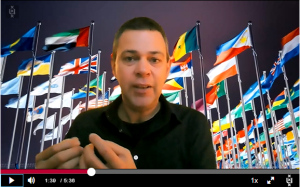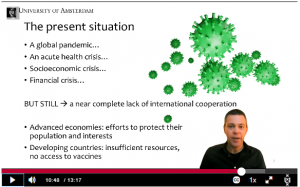
Grassroots: An example of how you can still offer knowledge clips with limited resources and time
ICTO had applied for a Grassroots grant for Political Science lecturer Roel van Engelen when the pandemic started. They wanted to give him the opportunity to use this grant for ICT applications in education to make a good innovation in his course ‘Introduction to International Relations’, by developing and creating knowledge clips. The creation of short knowledge clips is a way of offering teaching material interactively and applying the flipped classroom principle. Students watch the knowledge clip prior to the lecture. In this way they are better prepared for the lecture and the teacher can go into more depth during the lessons. This makes the lecture more attractive for both student and teacher. To create the knowledge clips, Roel van Engelen used the video platform Kaltura, which is conveniently integrated into Canvas.
 |
Roel van Engelen, lecturer in International Relations/Political Economy, assessment coordinator BA Political Science
|
Features of Kaltura
With Kaltura you can easily record knowledge clips and make videos interactive. Instead of explaining the same things every year during a lecture, you can offer that as a knowledge clip prior to the lecture. If the content is good and timeless, you can keep knowledge clips as a basis and add something from current events to update. This way they will last longer than one academic year, until you think it is better to replace them altogether. To avoid a clip consisting only of a “talking head,” which is not motivating for students, start thinking more creatively about how to improve a knowledge clip. For example, by building in questions and moments of reflection. That’s where the student has to stop and reflect on a particular question, and look further when the question is answered. It is very convenient that Kaltura offers that feature. Furthermore, you can also add external excerpts from the web. The lecture itself, through the use of knowledge clips and the flipped classroom idea, becomes more of a unique interaction moment in which you can go even deeper into the material.
During the lockdowns, we were not allowed to lecture on-campus, so the knowledge clips in my course ended up being a replacement for the entire lecture. Although this did not allow my knowledge clips to reach their full potential of a true flipped classroom, they did provide the best way to present the lecture material to the students. In that sense, the timing of my grant award was actually perfect which allow, allowing me to develop and use those clips as information transfer.
Cut-up old lectures as a basis for knowledge clips
Because Kaltura is integrated into Canvas, you don’t have to install anything for it. It’s already there and it’s nice that it allows you to work in one place. Online you can find information about Kaltura and TLC also offers Kaltura training on demand. It’s a fairly intuitive program, but you do need to spend an afternoon or so working on it. When you make knowledge clips yourself for the first time, you have to develop something new, think about what you can do with knowledge clips. You have to make your own step-by-step plan; it’s not readily available. Due to time constraints, I haven’t even been able to use all the features of Kaltura yet, but found an interim solution to make knowledge clips quickly and easily.
Initially, I chose to cut existing lecture recordings into shorter chunks, supplemented by a new weekly “start of the week” clip that briefly introduced the material and related it to current events. I had the recordings of my old lectures put into Kaltura by the web lecture service. Those web lectures were the basis for my knowledge clips. With Kaltura it is fairly easy to edit and cut longer lecture recordings into shorter clips, based on time stamps. With just a little editing, you can edit essential information into small chunks. I wrote a “script” – what needed to go where – and outsourced the editing to my colleagues at ICTO, because even though it’s fairly easy to do, it still takes time and I didn’t have the time myself. I wrote a storyboard, a table of starting and ending times for the various fragments, at which minute/second I wanted something, the explanation of theory or a concept, so that ICTO could easily edit this for me. I then built in intermediate quiz questions or reflection points into the clips myself.
Students appreciate knowledge clips and learn something from them
On Monday morning, I published my ‘start of the week’ video, recorded via my laptop, in which I announced the week’s themes, along with a series of between 3 and 6 knowledge clips about that week’s course material. I indicated which clips they should watch and also referred to the weekly structure which could also be found on the Canvas page. By doing this, I provided students with a clear structure and framework.

However, knowledge clips are never a total replacement for the lecture, but can contribute in discussing dry theory or explaining more complex information. A lecture provides social cohesion and contributes to academic citizenship, but it is less interactive. Working groups can and perhaps should become more interactive. Incidentally, now that I am back teaching fully on campus, I notice that I make less use of my knowledge clips. I regularly have students watch a clip about a case on YouTube beforehand. I now give the weekly review again live at the beginning of the lecture.
It doesn't have to be perfect
I am an example of how you can still offer something in the area of knowledge clips with relatively few resources and little time. My approach has been a reasonable ‘quick win’, as far as I am concerned a first step towards the development of knowledge clips. Ask the web lecture service to put your lecture recordings in Kaltura and then you can get started. The main lesson for me was that you can play around with lecture recordings a bit, which takes little time and still allows you to create something resembling knowledge clips fairly easily, which is appreciated by students. If you show integral web lectures, students quickly drop out. By doing so, you actually show that you don’t want to put any effort into it. With these simple knowledge clips you make the material accessible and manageable. So if you have little time, then this is a possibility, a first step.
It doesn’t have to be perfect. Anything is better than presenting integral recordings of lectures. Look at what material you already have and get to work on your first clip. If you get the hang of it, more will follow and you’ll get a better understanding of how to make it more and more professional. By now I have about 35. Editing in itself is not difficult, but it does take a fair amount of time. That’s why I ended up outsourcing the editing to ICTO. I think that investing in the creation of knowledge clips ultimately saves time if you use the clips for longer than an academic year.
Further development of knowledge clips
I was more or less put on the spot by ICTO’s grant application to start making knowledge clips. Which was a good thing, because I learned a lot and developed something that I would probably have posponed if they hadn’t taken that step for me. Further development is currently on hold again due to lack of time, but I plan to try to educate myself in recording the clips that are already out there more professionally. Maybe recording in a studio or buying a good lamp, webcam and green screen, do something with a background. In Zoom, for example, you can put yourself in the powerpoint presentation. Because of all the accessible software, a lot is possible. But that brings with it new issues of costs and hours, while as a teacher you are always struggling with workload and lack of time. That’s quite a practical hurdle.
I am glad that there is something like the UvA Grassroots Scholarship, to stimulate and apply innovation in education. But even if you have such a grant you have to do a lot yourself, because there is no structural support and you don’t get hours for it. Hours are more important than euros, and teachers are already at their limit in terms of hours. It is not motivating for many teachers if there are no hours available, because they simply do not have the time. You work on this kind of project in your own time and independently. I am slowly going to think further about the content and structure of the clips how I can use these clips in combination with a physical lecture which can then be more of a Q&A session, for example. My use of knowledge clips during the pandemic was mainly a convenience solution, but it has certainly motivated me to take knowledge clips seriously as an instrument of information transfer and to think further about how they can be used structurally in my teaching.
 |
Kaltura workshop and information
TLC central offers online Kaltura training for UvA teachers, customized for experience and expertise, upon request. More information?
Check the following links…
- …to make an appointment for an online training
- …to ask a question
- …for a recording of the Kaltura training
Click here for more information about Kultura and all its features at a glance
Grassroots grants
Grassroots are small-scale, low-threshold projects in which students and/or teachers use an ICT application to enrich, improve and/or intensify education. The results of a Grassroots project are used directly in education.
Timesaver tip: Lecturers often hire student assistants from the amount of money they receive from Grassroots to support them.






